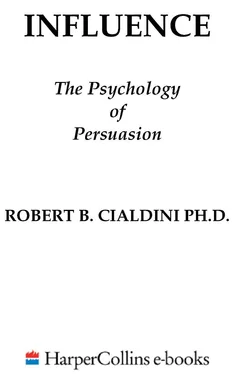3. In fact, Milgram first began his investigations in an attempt to understand how the German citizenry could have participated in the concentration-camp destruction of millions of innocents during the years of Nazi ascendancy. After testing his experimental procedures in the United States, he had planned to take them to Germany, a country whose populace he was sure would provide enough obedience for a full-blown scientific analysis of the concept. That first eye-opening experiment in New Haven, Connecticut, however, made it clear that he could save his money and stay close to home. "I found so much obedience," he has said, "I hardly saw the need of taking the experiment to Germany."
More telling evidence, perhaps, of a willingness within the American character to submit to authorized command comes from a national survey taken after the trial of Lieutenant William Calley, who ordered his soldiers to kill the inhabitants—from the infants and toddlers through their parents and grandparents—of My Lai, Vietnam (Kelman and Hamilton, 1989). A majority of Americans (51 percent) responded that, if so ordered, in a similar context, they too would shoot all the residents of a Vietnamese village. But Americans have no monopoly on the need to obey. When Milgram's basic procedure has been repeated in Holland, Germany, Spain, Italy, Australia, and Jordan, the results have been similar. See Meeus and Raaijmakers for a review.
4. We are not the only species to give sometimes wrongheaded deference to those in authority positions. In monkey colonies, where rigid dominance hierarchies exist, beneficial innovations (like learning how to use a stick to bring food into the cage area) do not spread quickly through the group unless they are taught first to a dominant animal. When a lower animal is taught the new concept first, the rest of the colony remains mostly oblivious to its value. One study, cited by Ardry (1970), on the introduction of new food tastes to Japanese monkeys provides a nice illustration. In one troop, a taste for caramels was developed by introducing this new food into the diet of young peripherals, low on the status ladder. The taste for caramels inched slowly up the ranks: A year and a half later, only 51 percent of the colony had acquired it, and still none of the leaders. Contrast this with what happened in a second troop where wheat was introduced first to the leader: Wheat eating—to this point unknown to these monkeys—spread through the whole colony within four hours.
5. The experiment was performed by Wilson (1968).
6. The study on children's judgments of coins was done by Bruner and Goodman (1947). The study on college students' judgments was done by Dukes and Bevan (1952). In addition to the relationship between importance (status) and perceived size that both of these experiments show, there is even some evidence that the importance we assign to our identity is reflected in the size of a frequent symbol of that identity: our signature. The psychologist Richard Zweigenhaft (1970) has collected data suggesting that as a man's sense of his own status grows, so does the size of his signature. This finding may give us a secret way of discovering how the people around us view their own status and importance: Simply compare the size of their signature to that of their other handwriting.
7. Subhumans are not alone in this regard, even in modern times. For example, since 1900 the U.S. presidency has been won by the taller of the major-party candidates in twenty-one of the twenty-four elections.
8. From Hofling et al. (1966).
9. Additional data collected in the same study suggest that nurses may not be conscious of the extent to which the title Doctor sways their judgments and actions. A separate group of thirty-three nurses and student nurses were asked what they would have done in the experimental situation. Contrary to the actual findings, only two predicted that they would have given the medication as ordered.
10. See Bickman (1974) for a complete account of this research. Similar results have been obtained when the requester was female (Bushman, 1988).
11. This experiment was conducted by Lefkowitz, Blake, and Mouton (1955).
12. The horn-honking study was published in 1968 by Anthony Doob and Alan Gross.
13. For evidence, see Choo (1964), and McGuinnies and Ward (1980).
14. See Settle and Gorden (1974), Smith and Hunt (1978), and Hunt, Domzal, and Kernan (1981).
CHAPTER 7 (PAGES 237-272)
1. The home-insulation study was done by Gonzales, Costanzo, and Aronson (1988) in northern California; the breast-examination work was conducted by Meyerwitz and Chaiken (1987) in New York City.
2. See Schwartz (1980) for evidence of such a process.
3. See Lynn (1989). Without wishing to minimize the advantages of this type of shortcut or the dangers associated with it, I should note that these advantages and dangers are essentially the same ones we have examined in previous chapters. Accordingly, I will not focus on this theme in the remainder of the present chapter, except to say at this point that the key to using properly the shortcut feature of scarcity is to be alert to the distinction between naturally occurring, honest scarcity and the fabricated variety favored by certain compliance practitioners.
4. The original reactance-theory formulation appeared in Brehm
(1966); a subsequent version appears in Brehm and Brehm (1981).
5. Brehm and Weintraub (1977) did the barrier experiment. It should be noted that two-year-old girls in the study did not show the same resistant response to the large barrier as did the boys. This does not seem to be because girls don't oppose attempts to limit their freedoms. Instead, it appears that they are primarily reactant to restrictions that come from other people rather than from physical barriers (Brehm, 1983).
6. For descriptions of the two-year-old's change in self-perception, see Mahler et al. (1975), Lewis and Brooks-Gunn (1979), Brooks-Gun and Lewis (1982), and Levine (1983).
7. The occurrence of the Romeo and Juliet effect should not be interpreted as a warning to parents to be always accepting of their teenagers' romantic choices. New players at this delicate game are likely to err often and, consequently, would benefit from the direction of an adult with greater perspective and experience. In providing such direction, parents should recognize that teenagers, who see themselves as young adults, will not respond well to control attempts that are typical of parent-child relationships. Especially in the clearly adult arena of mating, adult tools of influence (preference and persuasion) will be more effective than traditional forms of parental control (prohibitions and punishments). Although the experience of the Montague and Capulet families is an extreme example, heavy-handed restrictions on a young romantic alliance may well turn it clandestine, torrid, and sad.
A full description of the Colorado couples study can be found in Driscoll et al. (1972).
8. See Mazis (1975) and Mazis et al. (1973) for formal reports of the phosphate study.
9. For evidence, see Ashmore et al. (1971), Wicklund and Brehm (1974), Worchel and Arnold (1973), Worchel et al. (1975), and Worchel (1991).
10. The Purdue study was done by Zellinger et al. (1974).
11. The University of Chicago jury experiment on inadmissible evidence was reported by Broeder (1959).
12. The initial statements of commodity theory appeared in Brock (1968) and Fromkin and Brock (1971). For an updated statement, see Brock and Bannon (1992).
13. For ethical reasons, the information provided to the customers was always true. There was an impending beef shortage and this news had, indeed, come to the company through its exclusive sources. See Knishinsky (1982) for full details of the project.
Читать дальше












